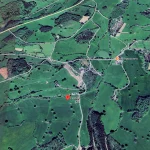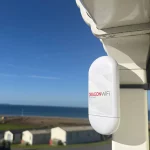UPD Mobile Operators Moan Over Lack of Access to Openreach’s Cable Ducts
Mobile operators O2, Three UK and Vodafone have warned that a recent decision by Ofcom, which prevented them from accessing Openreach’s (BT) existing cable ducts and telegraph poles in order to build new fibre optic backhaul links, could hinder the deployment of future ultrafast 5G Mobile services.
The first commercial 5G services are expected to launch in 2020 and this technology will eventually be able to support some ridiculously fast Mobile Broadband connections. The official 5G standard is aiming to support a “minimum” peak download speed of 20Gbps (Gigabits per second) and uploads of 10Gbps (shared capacity), with latency times of around 1-4ms (milliseconds).
However mobile operators are worried that they will struggle to feed their future 5G access points / base stations or masts with enough capacity to support the service. At present many operators feed their infrastructure with a mix of Microwave (radio) or traditional leased lines and a lot of those are purchased from BT (as well as others like Virgin Media, Cityfibre etc.), although a report in Light Reading suggests that operators have become unhappy with BT’s prices and service levels etc.
Advertisement
A Spokesperson for Three UK said:
“There is no provision for opening up the duct and pole network for operators who wish to invest mainly in mobile backhaul and fixed wireless access. This is an oversight by the regulator which must be remedied.”
In response Ofcom had initially proposed a solution via the new Duct and Pole Access (DPA) product, which would allow Openreach’s existing telegraph poles and underground cable ducts to be used by rivals in order to deploy new ultrafast broadband services.
Funnily enough Openreach already offers a similar Physical Infrastructure Access (PIA) product, although rivals have long complained that this solution is cumbersome (administration), suffers from awkward costs and was intended more for helping to connect residential homes (i.e. using it to provide leased line style rural backhaul or big business connectivity wasn’t possible).
The regulator’s plan for DPA thus initially supported a so-called “any usage” model, which would have enabled rivals to use Openreach’s network in order to build their own ultrafast broadband networks for both business and residential use, as well as for leased lines / backhaul solutions.
However Ofcom dropped the “any usage” model in favour of a “mixed-use” approach during April 2017 (here), partly due to fears that it could impact BT’s ability to recover its costs. In other words, companies can lay fibre for consumers and large businesses, provided the purpose of the network is primarily to deliver broadband to homes and small offices, but not for leased lines / mobile backhaul.
Advertisement
Ofcom’s Reasoning (Consultation)
Our preference would be to impose a general PIA obligation (i.e. one that does not include any usage restrictions) given the risk of regulatory failure from imposing such restrictions, such as limiting flexibility and technology choices. In the absence of any incentives on telecoms providers to use the PIA remedy to provide services that are not reliant on inputs from the WLA market, this would be the simplest and most effective way of ensuring that the PIA remedy is flexible enough to accommodate the mixed deployments necessary to make PIA effective.
However, given our understanding of the likely market dynamics over the next few years, we are concerned that in the absence of usage restrictions, there is a risk that some telecoms providers might use PIA only to build a limited number of high value point-to-point leased lines connections. Since such services are not part of the WLA market, or downstream from the WLA market, this would not promote greater network competition in accordance with our aims, and would not be consistent with PIA as a remedy in the WLA market.
The frustration is plain to see when looking at some of the responses to Ofcom’s related consultation (here – scroll to the bottom). O2 said, “Ofcom repeatedly cites the risk of ‘regulatory failure’ as being the reason why it considers it inappropriate to put in place an unconstrained PIA obligation … [but they have] not provided any detail as to why it considers this to be the case.”
Similarly Vodafone has highlighted that other countries, such as France, Portugal and Spain, already allow similar use of their incumbents duct networks for leased lines / mobile backhaul. The European Commission is also known to dispute Ofcom’s position on duct usage and instead the EC “considered that the risks could be mitigated by the use of a uniform costing methodology.”
On top of that the change was proposed at a time when Ofcom were still expecting to force Openreach into adopting another controversial approach, Dark Fibre (i.e. enabling rivals to install their own equipment at either end of existing fibre within cable ducts). Unfortunately the regulator got its market definitions for the UK wrong and the planned Dark Fibre launch has now been shelved (here), at least until they can propose a solution.
An Openreach Spokesperson told ISPreview.co.uk:
“In its 2016 Business Connectivity Market Review (BCMR), Ofcom decided not to impose duct and pole access on Openreach for the provision of leased lines to businesses.
We anticipate that Ofcom will consider duct and pole access for the provision of leased lines in the next Business Connectivity Market Review. We expect Ofcom to start work on this soon.”
Suffice to say that BT’s rivals consider that both the loss of an “any usage” model from DPA and the lack of Dark Fibre will have a negative impact on the business case for 5G (translation – they’ll still deploy it, but it’s going to cost a fair bit more). Meanwhile BT / EE should be able to harness some benefit from their own fixed line network (note: Vodafone also has quite a strong fixed line network via the old Cable & Wireless platform).
Advertisement
However, judging by Openreach’s comment, Ofcom may be about to update their DPA proposals.. again.
UPDATE 4:29pm
Added a comment from Openreach above.
Mark is a professional technology writer, IT consultant and computer engineer from Dorset (England), he also founded ISPreview in 1999 and enjoys analysing the latest telecoms and broadband developments. Find me on X (Twitter), Mastodon, Facebook, BlueSky, Threads.net and Linkedin.
« Scotland Commits to Free Urban WiFi and Business Rates Relief on New Fibre

















































Comments are closed